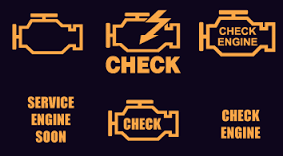Flashing Check Engine Light
What does a flashing check engine light mean?
A flashing check engine light means your

Different types of “Check Engine” lights
engine is experiencing a misfire problem that is serious enough to cause substantial, costly and permanent damage to your catalytic converter(s). Replacing a melted catalytic converter can easily cost you $1,000 to $3,000.
A check engine light usually comes on due to the failure of an emissions related sensor or component. But it can also come on to alert you to a problem with your antilock brake system (ABS), stability control or transmission (although a fault in those systems would also light a secondary warning light).
Can you continue driving with a solid check engine light?
As long as the vehicle is running smoothly and you’re not detecting acceleration, bucking, or stalling problems, you can continue driving until you can get it into a shop. If your vehicle does have performance issues, keep driving but book a service appointment as soon as possible.
What to do if you have a flashing check engine light
1) Lighten up on the accelerator to see if the flashing stops. If it does and you can get to a shop safely at the slower speed, drive to a shop and leave the vehicle there. Call a friend, Uber or Lyft to get home.
2) If the check engine light continues to flash even after you’ve back off the accelerator, you’ll have to get it towed to a shop. Pull over to a safe place, turn on your hazard flashers and call a tow truck. If you’re on the highway, slow down and get off on the nearest exit. Then call a tow truck.
How does a flashing check engine light misfire damage a catalytic converter?
When a cylinder misfires, unburned fuel enters the catalytic converter. The catalytic converter’s job is to incinerate excess fuel to keep emissions low. During a prolonged misfire cycle the temperature inside the catalytic reaction can rise from around a normal 400°F to over a destructive 2,500°. That high temperature causes the ceramic grid to melt. Once the ceramic grid melts, the converter is totally destroyed and must be replaced.
Worse yet, many newer vehicles have multiple catalytic converters. If you keep driving with a flashing check engine light, you could easily boost your repair bill by several thousand dollars. Think about this: If an ignition coil fails and causes a flashing check engine light, the tow, diagnostic fee, and coil replacement will cost around $500. If you keep driving and damage the catalytic converter(s), your repair bill will be $500 plus an additional $1,200 to $2,500 for the damaged catalytic converter(s).
For more information on how catalytic converters work, read this article
©, 2013 Rick Muscoplat
Posted on by Rick Muscoplat